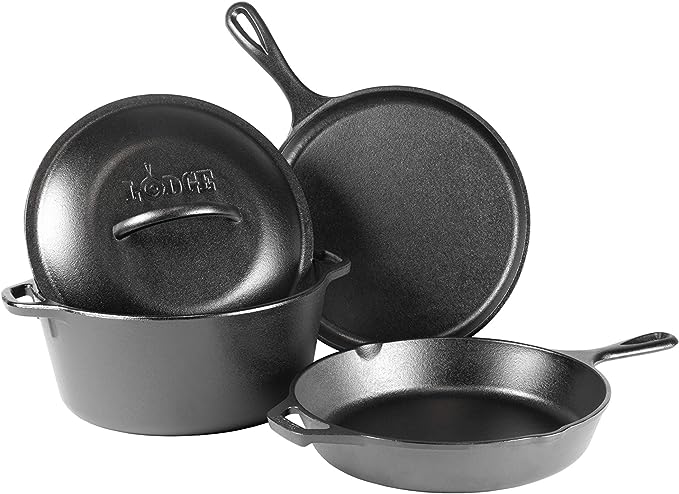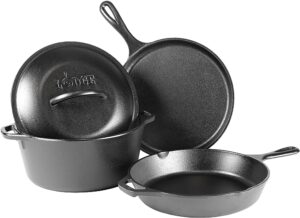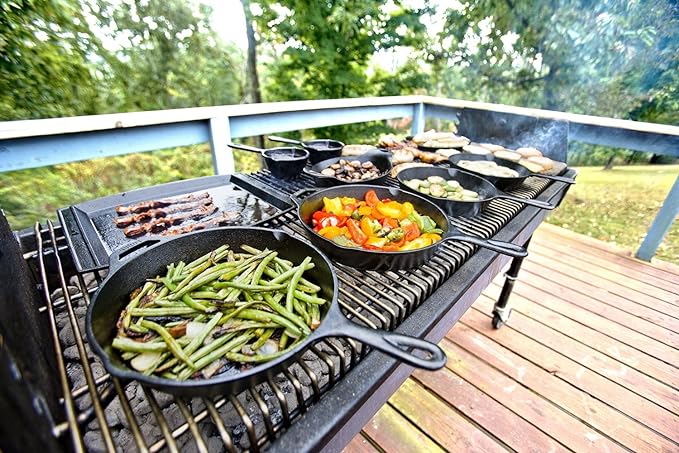Cooking with Cast Iron in 2024: Appreciating the Amazing Heft and Heat

Cast iron cookware has a special place in the hearts of cooks everywhere. It’s durable, versatile, and when taken care of properly, it can last for generations. But cooking with it requires a bit of know-how to get the most out of it. Let’s delve into the secrets of cast iron cooking, from seasoning your pan to mastering the art of even heating.
Table of Contents
The Beauty of Cast Iron
Before we get into it, let’s appreciate what makes this cookware so great. Its ability to retain and evenly distribute heat is unmatched, making it perfect for everything from searing steaks to baking cornbread. Plus, cooking with cast iron can even add a bit of iron to your diet, a little-known health perk.
Seasoning Your Cast Iron
One of the most crucial aspects of cooking with cast-iron is maintaining its seasoning. Seasoning is the process of baking oil into the iron to create a natural, non-stick surface. Here’s how to do it:
1. Clean the Pan: Start with a clean, dry pan. If it’s new, give it a quick wash to remove any factory residue.
2. Apply Oil: Use a paper towel to rub a thin layer of oil (like vegetable, canola, or flaxseed oil) all over the pan, including the handle and bottom.
3. Bake It: Place the pan upside down in the oven and bake at 375°F (190°C) for an hour. Put a sheet of aluminum foil on the rack below to catch any drips.
4. Cool Down: Let the pan cool in the oven before taking it out.
Regular seasoning not only keeps your cast iron non-stick but also protects it from rust.
Order The Perfect Cat Iron Cookware Set Now
Cooking Tips for Cast Iron
Cooking with this kind of cookware is a bit different from using other types of cookware. Here are some tips to get the best results:
Preheat Gradually
Cast-iron takes a little longer to heat up, but once it does, it retains that heat for a long time. Preheat your pan gradually to avoid hot spots and ensure even cooking. Start on low heat and slowly increase to your desired cooking temperature.
Use Enough Oil
While cast-iron can develop a non-stick surface over time, it’s still important to use enough oil when cooking to prevent sticking and to maintain the seasoning. Whether you’re frying eggs or sautéing vegetables, a bit of oil goes a long way.
Order The Perfect Cat Iron Skillet Now
Avoid Acidic Foods Early On
In the beginning stages of cooking with cast-iron, avoid cooking highly acidic foods like tomatoes and citrus. These can strip away the seasoning. Once your pan is well-seasoned, it can handle these foods better.
Cleaning and Maintenance
Proper cleaning is vital for the longevity of this cookware. Here’s how to do it right:
Clean While Warm
After cooking, let your pan cool down slightly, but not completely. Warm water helps loosen food residue more easily. Use a brush or a sponge to scrub the pan. Avoid using soap, as it can strip away the seasoning.
Dry Immediately
Prevent rust by drying your cast iron immediately after washing. You can place it on the stove over low heat to ensure all moisture evaporates.
Reapply Oil
After drying, apply a thin layer of oil to the pan to maintain the seasoning and protect it from rust. Wipe away any excess oil with a paper towel.
Tackling Rust and Build-Up
Sometimes, even with the best care, cast-iron can develop rust or build-up. Here’s how to handle it:
Order The Perfect Cat Iron Cookware Set Now
For Rust
Scrub the rusty area with steel wool until the rust is gone. Wash the pan thoroughly, dry it completely, and then re-season it.
For Build-Up
If your cast-iron develops a sticky build-up, it’s usually due to too much oil. Scrub the pan with coarse salt and a bit of water to remove the build-up, rinse, dry, and then lightly re-season.
Order The Perfect Cat Iron Skillet Now
Cooking Techniques for Cast Iron
Cast-iron is incredibly versatile. Here are some techniques to make the most of it:
Searing
The even heat distribution makes cast-iron perfect for searing. Whether it’s a steak or chicken breasts, you’ll get a beautiful, even crust.
Baking
Cast-iron’s heat retention makes it great for baking. Cornbread, pizza, and even cakes can be baked in a cast iron pan for a unique flavor and texture.
Braising
Because it retains heat so well, cast-iron is excellent for slow-cooking and braising. It maintains a steady temperature, ensuring your meat becomes tender and flavorful.
Order The Perfect Cat Iron Cookware Set Now
Appreciating the Cast Iron Lifestyle
Cooking with cast-iron is more than just a method; it’s a lifestyle. It connects you to generations of cooks who have used these sturdy pans to prepare meals with love and care. Each time you cook with it, you’re adding to its seasoning and its story.
Final Thoughts
Mastering the art of cooking with cast iron takes a bit of practice and patience, but the rewards are well worth it. With proper care and use, this amazing cookware can become a kitchen heirloom, providing delicious meals for years to come. So, heat up that skillet, season it well, and enjoy the timeless joy of cooking with cast iron!
Read More:
5 Easy Electric Griddle Recipes








